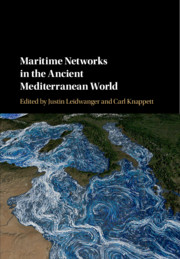Book contents
- Maritime Networks in the Ancient Mediterranean World
- Maritime Networks in the Ancient Mediterranean World
- Copyright page
- Contents
- Figures
- Tables
- Contributors
- Preface
- Chapter One Maritime Networks, Connectivity, and Mobility in the Ancient Mediterranean
- Chapter Two Robust Spatial Network Analysis*
- Chapter Three New Approaches to the Theran Eruption
- Chapter Four Geography Matters
- Chapter Five Cults, Cabotage, and Connectivity
- Chapter Six Shipwrecks as Indices of Archaic Mediterranean Trade Networks*
- Chapter Seven Netlogo Simulations and the Use of Transport Amphoras in Antiquity*
- Chapter Eight Lessons Learned from the Uninformative Use of Network Science Techniques
- Chapter Nine Amphoras, Networks, and Byzantine Maritime Trade
- Chapter Ten Navigating Mediterranean Archaeology’s Maritime Networks
- Index
- References
Chapter Nine - Amphoras, Networks, and Byzantine Maritime Trade
Published online by Cambridge University Press: 05 November 2018
- Maritime Networks in the Ancient Mediterranean World
- Maritime Networks in the Ancient Mediterranean World
- Copyright page
- Contents
- Figures
- Tables
- Contributors
- Preface
- Chapter One Maritime Networks, Connectivity, and Mobility in the Ancient Mediterranean
- Chapter Two Robust Spatial Network Analysis*
- Chapter Three New Approaches to the Theran Eruption
- Chapter Four Geography Matters
- Chapter Five Cults, Cabotage, and Connectivity
- Chapter Six Shipwrecks as Indices of Archaic Mediterranean Trade Networks*
- Chapter Seven Netlogo Simulations and the Use of Transport Amphoras in Antiquity*
- Chapter Eight Lessons Learned from the Uninformative Use of Network Science Techniques
- Chapter Nine Amphoras, Networks, and Byzantine Maritime Trade
- Chapter Ten Navigating Mediterranean Archaeology’s Maritime Networks
- Index
- References
Summary

- Type
- Chapter
- Information
- Maritime Networks in the Ancient Mediterranean World , pp. 219 - 237Publisher: Cambridge University PressPrint publication year: 2018
References
- 3
- Cited by

